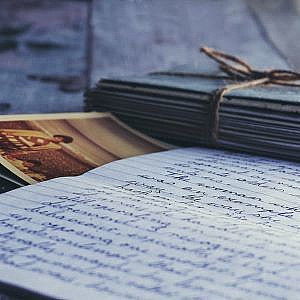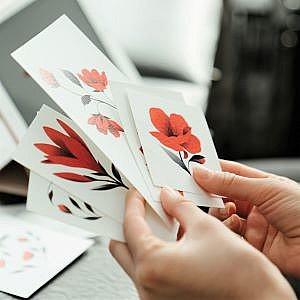Sentimental Paperwork: How to sort it out and keep only the things you love!
In this post, Carole Reed, owner of organising business HappySort, shares her insights into dealing with sentimental paperwork - items such as letters, cards and drawings that can be difficult to address when we are decluttering.How to sort sentimental paperwork
When talking about sentimental paperwork, I'm referring to letters, cards and drawings. These items are notoriously hard to deal with and many professional organisers recommend that you leave everything sentimental to the end of the decluttering process. Julie Holland, an assistant clinical professor of psychiatry at New York University talks about sentimental clutter being the "adult equivalent of a teddy bear." Jennifer Baumgartner, a practising clinical psychologist who runs a wardrobe consulting business, notes that, "we infuse our junk with the spirit of a moment in time, associating the tangible with the intangible. Our junk becomes the object upon which we project our internal experience." This is why some people find it almost impossible to throw anything away.Why do I need to get rid of things I find it hard to part with?
Try and think about this process as keeping the pieces that mean the most to you, not about getting rid of stuff. If you have an enormous house with lots of cupboards and storage space, then holding onto a lot of things may not be a problem. However, the reality is that most of us don't have the luxury of space so we are forced to streamline our possessions. Many people justify holding onto sentimental paperwork by thinking they are preserving memories and connections, and they find that comforting. Holding onto something and then storing it in an attic or cupboard is not the same as preserving it. Such an item has no meaningful purpose; it's just stored and often forgotten about. If you don't dispose of your sentimental items, one day your children or other family members will have to go through them. Try to teach your children good habits about only keeping the most precious and special items. Don't burden them with the task, and associated guilt, of having to throw away the things that you found difficult to deal with. If you keep EVERYTHING then nothing stands out; special things get lost amongst all the other things you have attached sentimental value to. If you keep back a manageable number of items that mean a lot to you, you can display them or keep them in a way that means you can still look at them and enjoy them. Sentimental items can bring joy, but they can also prevent you from moving forward with your life. Why do you need to keep hundreds of letters from your first love? Choose one or two at most and discard the rest. People often keep things even though it makes them unhappy or guilty to look at them. Nobody needs to keep things that make them feel bad about themselves. Sometimes we feel guilt over discarding sentimental paperwork. Perhaps there are cards from deceased family members or artwork from long grown up children. We fear that the memory of that person, or those times, will disappear with the item. In reality you are getting rid of the item, not the memory. You are not feeling sentimental or nostalgic about the object, but about the person, place or time.
How do I start?
There are many different ways of tackling this kind of project; here are some of them:- Just start! Pick the box/table/drawer that you think that you will find the easiest.
- Maybe set a time frame/limit for each session so that you don't get overwhelmed.
- Put items into dump/keep/revisit piles. Work quickly. If you don't know what to do with something, put it in the revisit pile.
- Ask yourself, does this item evoke happy memories? Is it helping me to live the life I want to live? If it doesn't, get rid of it.
- If you have multiple letters which you want to read, put them in the revisit pile. The first session is to try and get rid of some of the easy things initially.
- Put only the cards with meaningful messages in the revisit pile and discard the ones with no message.
- Keep only the best 'artwork' your children have done: the pieces you like best or that you know they have spent the most time on. Plan on keeping 50% during the first session and discarding more at a later date.
- If you are keeping hold of items because you have not had a chance to process what the memory means to you, then think about the item and the times associated with it to discover if it's worth holding onto.
- Revisit the difficult pile. Read all the letters, enjoy the messages in the cards. Don't feel guilty about getting rid of them. Remember that you are doing this to free up physical and mental space. If it is still impossible to get rid of something, put it in a box for 3-6 months and revisit it. If, at the end of that time, you have not missed the item, or thought about it, it is time to let it go.
- Work in layers and don't go for the hardest things first. It's fine to go back to items. Keep your goal in your head; remember why you are doing this.
- Keep going. Yes, it will be hard but the more you do, the easier it will get.

Re-purposing sentimental paperwork
Much sentimental paperwork can be re-purposed, you don't need to throw it all away. This is harder to do with paperwork than it is with say books, clothes or family heirlooms but it can be done. It can be a lot of work to repurpose something but hopefully this will be part of the process of helping you to realise whether an item is really worth keeping after all. Here are some ideas:- Keep only the best and most memorable pieces. How much you keep is up to you and your capacity (mental and spatial) to store it.
- Photograph the items (letters, photos, art) and keep the images in a folder on your computer or phone.
- Gift artwork to relatives or friends.
- Use drawings as wrapping paper.
- Make a collage and hang it on the wall or a door. This can be done with your child if you're working with their drawings. Cut out the best bits and stick them on a large piece of card.
- Open an Instagram account or blog to showcase your child's artwork. I know parents who have done this. This way family and friends can enjoy the art too.
- Digitise it into a coffee table book. There are numerous companies that do this. A simple Google search will bring up lots of options.
- Frame it/them. Change the displays every year or so.
- Re-purpose pictures into cards to send to people.
- Make place mats. A Google search will show you how.
- Put cards into a ring binder. This allows them to be enjoyed and stored neatly.
If this post has inspired you to get to work with your own sentimental items and you would like some help, you can find your nearest APDO-registered professional organiser on our Find An Organised database.
